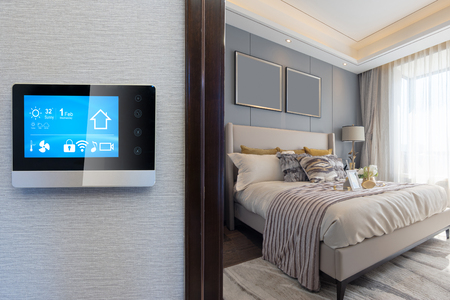1. Understanding Smart Thermostats
Smart thermostats are a modern upgrade to traditional home temperature control systems. Unlike the old-fashioned manual or programmable thermostats, smart thermostats connect to your Wi-Fi network and give you the ability to control your homes heating and cooling remotely using a smartphone, tablet, or voice assistant like Alexa or Google Assistant.
What Makes Smart Thermostats “Smart”?
The main difference between smart thermostats and traditional ones lies in their ability to learn and adapt. Many smart models can learn your daily routine and adjust temperatures accordingly, helping reduce energy usage when youre not home. They also provide real-time data and usage reports that help homeowners better understand how they use energy.
Key Features of Smart Thermostats
| Feature | Description |
|---|---|
| Remote Access | Control your thermostat from anywhere using a mobile app. |
| Learning Capabilities | Some models learn your habits and adjust temperatures automatically. |
| Geofencing | Uses your phones location to know when youre home or away. |
| Energy Usage Reports | Track energy consumption and get tips to save more. |
| Voice Control | Integrates with smart home assistants for hands-free adjustments. |
| Zoning Support | Create different temperature zones in your home for better comfort and efficiency. |
How Do They Work?
A smart thermostat connects to your HVAC system just like a regular thermostat, but it uses sensors, algorithms, and internet connectivity to enhance its functionality. For example, if no one is home during the day, it can automatically lower the heat or raise the AC to save energy. When it senses youre on your way back—thanks to geofencing—it can return your home to a comfortable temperature before you arrive.
User-Friendly Experience
The setup process for most smart thermostats is straightforward, often guided by step-by-step instructions in the mobile app. Once installed, users typically find them intuitive to use with sleek touchscreen interfaces and easy scheduling features.
2. Energy Efficiency and Cost Savings
One of the biggest selling points of smart thermostats is their ability to help homeowners save money by reducing energy use. These devices use automation, intelligent scheduling, and learning features to optimize your heating and cooling systems — which can lead to noticeable drops in your monthly utility bills.
How Smart Thermostats Save Energy
Smart thermostats are designed to learn your daily routine and adjust the temperature accordingly. For example, they can automatically lower the heat or turn off the air conditioning when youre not home and start adjusting it again before you return. This kind of automation helps avoid wasted energy while keeping your home comfortable when it matters most.
Key Features That Boost Efficiency
- Learning Algorithms: Adapt to your habits over time and create custom schedules without needing manual input.
- Geofencing: Uses your smartphone’s location to determine if youre home or away, adjusting settings automatically.
- Remote Control: Allows you to manage settings from anywhere via a mobile app.
- Energy Usage Reports: Provide insights into how much energy youre using and offer tips to improve efficiency.
Potential Monthly Savings
The actual savings will vary depending on your local climate, energy rates, and usage patterns. However, studies have shown that many households can save between 10% to 20% annually on heating and cooling costs with a smart thermostat.
| Home Size | Estimated Annual Heating & Cooling Cost | Potential Savings (10-20%) |
|---|---|---|
| Small Apartment | $600 | $60 – $120 |
| Mid-Sized Home | $1,200 | $120 – $240 |
| Large Home | $2,000 | $200 – $400 |
Real-Life Scenarios Make a Difference
If you live in a region with extreme temperatures or if your schedule often changes, a smart thermostat can adapt more effectively than a traditional one. Over time, this adds up to meaningful energy savings without sacrificing comfort.

3. Upfront Costs and Installation
Before jumping into the world of smart thermostats, its important to understand the initial costs involved. While these devices can help reduce your energy bills over time, there are some upfront expenses to consider, including the price of the thermostat itself, installation costs, and any available rebates or incentives.
Cost of Smart Thermostats
Smart thermostats come in a variety of models and price ranges. Heres a quick comparison of popular options:
| Brand/Model | Approximate Price | Key Features |
|---|---|---|
| Google Nest Learning Thermostat | $200–$250 | Self-learning, remote control via app, energy usage reports |
| ecobee SmartThermostat with Voice Control | $220–$250 | Built-in Alexa, room sensors, energy reports |
| Amazon Smart Thermostat | $60–$80 | Basic smart features, Alexa compatibility, budget-friendly |
| Honeywell Home T9 Smart Thermostat | $180–$200 | Room sensors, scheduling features, mobile app control |
Installation Options and Costs
You have two main choices when it comes to installing your smart thermostat: DIY or hiring a professional.
DIY Installation
If youre comfortable handling basic electrical wiring and have a compatible HVAC system, you might be able to install the thermostat yourself. Many brands offer step-by-step guides and videos. DIY installation typically means no extra cost beyond the device itself.
Professional Installation
If youre not confident with wiring or your system is more complex (like if you lack a C-wire), hiring a pro is a safer bet. Professional installation generally costs between $100 and $200 depending on your location and the complexity of your setup.
Rebates and Incentives
Many utility companies across the U.S. offer rebates for installing ENERGY STAR® certified smart thermostats. These rebates can significantly offset the upfront cost. Check with your local utility provider or visit energystar.gov for programs in your area.
| Utility Provider (Example) | Rebate Amount | Eligibility Requirements |
|---|---|---|
| PGE (Pacific Gas & Electric) | Up to $75 | Must purchase qualifying model and be a residential customer |
| Duke Energy | $50–$75 rebate or bill credit | Smart thermostat must be enrolled in an energy-savings program |
| Xcel Energy | $50 rebate + optional demand response program savings | Smart thermostat must be Wi-Fi enabled and ENERGY STAR® certified |
The total investment in a smart thermostat may vary, but when factoring in potential rebates and energy savings over time, many homeowners find it well worth the initial cost.
4. Compatibility with HVAC Systems
Before investing in a smart thermostat, its essential to check whether it’s compatible with your current HVAC (heating, ventilation, and air conditioning) system. Not all smart thermostats work with every type of system, and getting the wrong one can lead to installation headaches or limited functionality.
Why Compatibility Matters
A smart thermostat works by communicating with your home’s heating and cooling equipment. If the thermostat isn’t designed to work with your system, it may not be able to control temperature settings properly—or worse, it might not function at all.
Common HVAC System Types
Here’s a quick overview of common HVAC systems and their compatibility with most smart thermostats:
| HVAC System Type | Description | Smart Thermostat Compatibility |
|---|---|---|
| Central Heating & Cooling (Forced Air) | Uses ducts to distribute heated or cooled air throughout the house | Most smart thermostats are compatible |
| Heat Pump Systems | Provides both heating and cooling using refrigerant cycles | Compatible with many models, but check for heat pump support |
| Radiant or Boiler Systems | Heats water and sends it through pipes or radiators | Limited compatibility; choose specific models designed for boilers |
| Multi-Stage Systems | Has multiple levels of heating or cooling for better efficiency | Some thermostats support multi-stage control—verify specs |
| Zoned HVAC Systems | Divides home into zones with separate climate control | Requires advanced thermostats or additional zone controllers |
C-Wire Requirement
Another key factor is the C-wire (common wire), which provides continuous power to your thermostat. Many older homes don’t have a C-wire, and some smart thermostats require one to operate. Some models offer workarounds, like power extenders or battery options, but it’s best to know what you’re working with before purchasing.
Tips for Checking Compatibility
- Check manufacturer websites: Most brands like Nest, Ecobee, and Honeywell offer online compatibility check tools.
- Look at your current thermostat wiring: Remove the cover and identify labeled wires (R, W, Y, G, C).
- If unsure, ask a pro: An HVAC technician or electrician can quickly determine if your system supports a smart thermostat.
Selecting a compatible smart thermostat ensures smooth integration and maximizes energy-saving features without technical issues.
5. User Experience and Convenience
One of the biggest reasons homeowners are switching to smart thermostats is the ease of use and added comfort they bring to everyday life. These devices aren’t just about saving energy—theyre about making your home smarter and your life easier. Let’s explore some of the top user-friendly features that come with many smart thermostat models.
Mobile Apps for On-the-Go Control
With mobile apps, you can control your thermostat from anywhere—whether youre at work, on vacation, or just lying in bed. These apps allow you to adjust the temperature, set schedules, and even receive alerts if something unusual happens (like a sudden temperature drop).
Common App Features:
| Feature | Description |
|---|---|
| Remote Temperature Control | Adjust heating or cooling from your smartphone. |
| Scheduling | Create daily or weekly temperature routines. |
| Energy Reports | View how much energy youre using and where you can save. |
| Alerts & Notifications | Get notified if your system needs maintenance or if temps go outside your set range. |
Voice Control Compatibility
Many smart thermostats work with popular voice assistants like Amazon Alexa, Google Assistant, and Apple HomeKit. This means you can simply say things like “Alexa, lower the temperature to 70 degrees” without lifting a finger. It’s especially handy when you’re cooking, relaxing, or heading out the door.
Learning Capabilities for Personalized Comfort
Certain smart thermostats learn your habits over time. For example, they might notice that you like it cooler at night and warmer in the morning—and automatically adjust settings to match. This not only improves comfort but also helps reduce unnecessary energy use.
User-Friendly Interfaces
The touchscreens on most smart thermostats are intuitive and easy to navigate. Bright displays, clear menus, and simple setup steps make them accessible—even for those who aren’t tech-savvy. Most models also offer guided installation through their app, so setting up is a breeze.
In Summary:
| User Feature | Main Benefit |
|---|---|
| Mobile App Access | Total control from anywhere at any time. |
| Voice Commands | No-touch adjustments using smart speakers. |
| Auto-Learning Modes | Tailored comfort based on your routine. |
| Simplified Interface | User-friendly design for all ages. |
If youre looking for a way to stay comfortable while saving energy effortlessly, these convenient features make smart thermostats a compelling choice for modern living.
6. Are Smart Thermostats Worth It?
When considering whether a smart thermostat is worth the investment, its important to look at more than just the price tag. Homeowners should analyze long-term value by weighing energy savings, comfort, and environmental impact. Heres how smart thermostats stack up in those areas:
Energy Savings Over Time
One of the biggest selling points of smart thermostats is their ability to reduce energy bills. By learning your schedule and adjusting temperatures automatically, these devices help cut down on unnecessary heating and cooling.
| Feature | Estimated Annual Savings |
|---|---|
| Automatic scheduling | $50–$100 |
| Remote control via app | $10–$30 |
| Usage insights and reports | $20–$40 |
| Total Potential Savings | $80–$170 per year |
Comfort & Convenience
Smart thermostats offer more than just savings—they also make everyday life easier. With features like voice control, geofencing, and learning algorithms, they adapt to your lifestyle without you having to lift a finger.
- Remote Access: Adjust temperature settings from anywhere using your smartphone.
- Learning Behavior: Some models learn your daily routines and automatically create optimized schedules.
- Integration with Smart Home Devices: Works seamlessly with systems like Alexa, Google Assistant, or Apple HomeKit.
Environmental Impact
If youre looking to reduce your carbon footprint, a smart thermostat can help. By optimizing energy use, it lowers greenhouse gas emissions associated with heating and cooling your home.
- Efficient Energy Use: Less wasted energy means fewer emissions from power plants.
- Sustainability Goals: Contributes to eco-friendly living and may support broader clean energy initiatives in your area.
The Bottom Line: Value vs. Cost
A typical smart thermostat costs between $100 and $250 upfront. While this might seem steep compared to traditional models, the potential yearly savings mean you could break even in as little as 1–3 years. Add in the convenience and environmental benefits, and its easy to see why many homeowners consider them a smart choice.
| Category | Traditional Thermostat | Smart Thermostat |
|---|---|---|
| Initial Cost | $25–$75 | $100–$250 |
| Annual Energy Savings | $0–$20 | $80–$170+ |
| User Convenience Features | No/Minimal | High (App control, automation) |
| Environmental Impact Reduction | Low | Moderate to High |
| Payback Period | N/A or Long-Term Only via Upgrades | 1–3 Years Average |
If youre looking for an upgrade that balances cost-saving potential with comfort and sustainability, investing in a smart thermostat could be well worth it.


